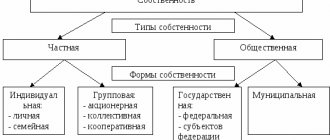We rely on legislative documents
The most important legislative documents that regulate property relations include:
- Constitution of the Russian Federation (Article 35).
- Civil Code of the Russian Federation (Article 260) – general provisions on property rights.
- Land Code of the Russian Federation, Article 15 – property rights for individuals and legal entities; Articles 16,17 – state lands; Articles 18,19 – property of the Subjects of the Federation, municipal lands.
- Civil Code of the Russian Federation Articles 567-571 – purchase and sale; Articles 572-582 – donation; Articles 1110 and 1111 – inheritance by law and by will.
- Federal Law on the Privatization of State and Municipal Property dated December 21, 2001, No. 178-FZ.
Grounds for the emergence of land ownership
Each plot registered as the property of an individual or legal entity has title documentation, which is also defined as title documentation. Read all the details about title and title documentation here.
Ownership of a land plot arises from the moment of receipt of this primary document, which the owner receives at the time of transfer of rights to the land plot in his favor. The designated document indicates the civil action that provided the land into the ownership of the person indicated in the documentation.
Among such actions that allow citizens to take possession of land (the grounds for the emergence of rights to land plots), the following can be identified:
- property transactions: purchase and sale, gift or exchange.
- Inherited property transferred from a deceased owner to a legal successor by will or by law in order of priority (you can find out the owner by cadastral number here).
- Privatization of municipal or state lands.
As a result of the indicated forms of transfer of rights, a transfer of ownership occurs from one owner (the transferor of the property) to another (the legal successor).
The design nuances are described in this material. If you need re-registration, read this article. Also, do not forget about forms of ownership:
- private;
- public, federal.
The issue of return of land plots
In legal practice, cases are common when the plaintiff raises the issue of the legality of the alienation of a land plot. If the procedure for terminating rights to an allotment has been violated (including by forcing a person to complete a transaction), then the subject of legal relations has legal grounds to file a vindication claim in court, which is a determinant for legal proceedings.
However, it must be remembered that the plaintiff must appeal only with facts that confirm the seizure of land plots, that is, the moment of termination of property rights against the will of the legal owner.
In this case, we are talking, for example, about recognizing the subject of legal relations as a civil plaintiff, which is carried out through the publication of a resolution signed by the investigative authorities.
Thus, we can conclude that no legal owner of a land plot can be deprived of the right to use it without his consent. Only a judicial body has the right to make such a decision, even in cases of transfer of private property to state property to meet the needs of the Russian Federation.
Author of the article
Transactions on alienation of land plots
Types of civil legal actions, as a result of which property is alienated from the owner, acquiring a new owner, are defined as property transactions. They are of a compensated nature, both in the case of purchase and sale or barter (exchange of plots), and gratuitous - donation of a plot.
Ownership of a land plot arises when it is acquired under a deed of sale - the most common type of property transaction. In this case, a bilateral agreement is drawn up, as a result of which one party alienates the land plot, accepting from the counterparty a proportionate payment corresponding to the cost of the site. Ownership passes to the buyer as a result of:
- registration of a civil contract;
- carrying out mutual settlements;
- registration of a property transaction in Rosreestr.
The registration authority enters the new owner of the land into the cadastral records, and his right to the land plot is established by the agreement, the received certificate of ownership and the cadastral passport of the land plot.
Barter agreement
With an exchange agreement, the legal procedure is similar, with the exception of the provision for mutual settlements. In this case, in exchange for alienated lands, persons receive equal (unequal) allotments or other real estate. In the event of an unequal exchange, it is allowed to collect or transfer to the counterparty an additional payment that regulates the proportionality of the property rights of the parties.
Donation differs from compensated transactions in the essence of the procedure . In this case it is unacceptable:
- collection of fees or other reciprocal services;
- putting forward counter conditions towards the donee.
The initiative to draw up a deed of gift can belong only to the donor. The donee has the right to accept the property or refuse it. Since these transactions are most often subject to termination, it is advisable to formalize them with a standard agreement prepared and certified by a notary. In paid transactions, notarization is carried out at the discretion of the parties.
Only after registration of the deed of gift has been completed, the donee assumes the status of owner of the land plot, receiving the appropriate documentation evidencing ownership and a cadastral passport. What to do if there are no documents?
Lands pledged as collateral or seized for non-fulfillment of debt obligations cannot be involved in property transactions.
What responsibility does the land owner have?
By receiving the right to land, the owner receives a share of responsibility with it. In any case, the land plot is located on the territory of the state and is part of the general ecosystem. Therefore, the legislator has the right to assign certain responsibilities to the land owner.
The first thing the site owner must take into account is the rights of other land users.
It should be noted that the state, represented by municipal authorities, allocates suburban land plots for certain types of use. The purpose of the land depends on:
- from geographical location;
- specifics of the allocated lands;
- natural natural purpose.
What does it mean to use a plot of land “for other purposes”?
If you have been allocated a plot for individual housing construction (IHC), then you are obliged to use it strictly for its intended purpose. This means that on the site you cannot:
- build commercial facilities;
- engage in business activities;
- engage in agricultural activities, etc.
Other land plots are allocated for these types of purposes.
If you fail to fulfill your responsibilities to the transferred property, there are consequences. Let's consider a simple example: you decide to build a cottage for permanent residence on a garden plot. Local authorities will not satisfy your request to put the facility into operation. Moreover, the squatter building may be demolished, and you will not be able to resell the land to another owner until all violations are eliminated.
Why is this happening? The construction of a private house must be carried out in accordance with urban planning and architectural standards. Unauthorized buildings may be unsafe, so permits for their operation will not be issued. In addition to these violations, there is also inappropriate use, leading to a decrease in the useful qualities of land resources.
Grounds and procedure for transferring ownership by inheritance
After the death of the owner of the land plot , upon presentation of the appropriate certificate, the inheritance is opened. Applicants for entry into property succession based on the degree of proximity of kinship and persons specified in the will submit an application for entry into inheritance.
If the land plot is alienated to a person on the basis of a testamentary disposition, he is issued a certificate of inheritance. The same happens if there is a single heir by law, which may be a close (or other) relative. With the indicated certificate, the heirs apply to Rosreestr for registration. After registration, the certificate of inheritance is accompanied by certificates of ownership and cadastral passports of the land plots, which guarantees the full legal capacity of the new owners.
If there is more than one heir, the land is transferred along with other property in the form of an inheritance estate. The certificate of ownership is transferred to the heirs, with a list of inherited property attached.
After receiving the certificate, you need to draw up an agreement on the division of property. In this case, options for registering ownership of land ownership appear:
- joint, common property, with or without distribution of shares.
- By allocating a land plot to one of the participants in exchange for other property that goes to the rest.
- By transferring the land plot to one participant, with the condition of subsequent payment of the cost of the shares to the others.
The agreement is drawn up during the voluntary distribution of the inheritance mass, by agreement . If there is no consensus, the issue is considered in court. In this case, instead of an agreement, a court decision on the division of property is used.
Having attached a court decision or a voluntary agreement to the certificate of inheritance, the legal successors of the deceased owner of the land plot register the plot in Rosreestr, receiving the relevant documentation.
Making a decision by the court
Often, regarding one piece of land, numerous disagreements arise between companies or individuals claiming to use and own the territory. Such disputes are resolved by the court, for which the following is taken into account:
- documents of each party related to the territory are studied;
- the person or company that has the title papers for the object wins the case;
- Each party is allowed to appeal.
If such a decision is available, it will not be difficult to formalize the right to the object.









